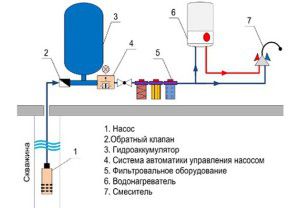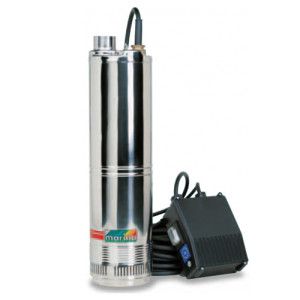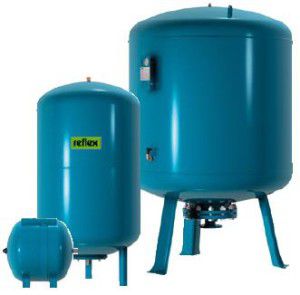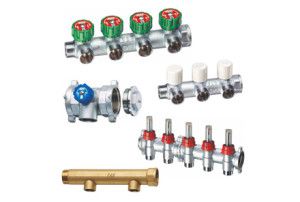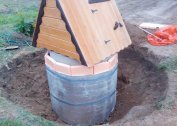The water supply system consists of many elements and structures that are interconnected. The quality of customer service directly depends on the choice of source, pipelines, accumulator, filters. How to choose a pump, expansion tank and pipes for water supply and what characteristics should I pay special attention to?
The main elements of the water supply system
In order to extract water, process it and supply it to the consumer, the water supply system should consist of the following elements:
- Water intake unit. It receives water of technical quality from natural sources;
- Pumping station (usually two) are used to deliver water to the treatment plant (NS-1) and then to the consumer (NS-2);
- Treatment facilities. This is a set of containers for water sludge, clarifiers, filters;
- Plumbingby which the resource is transported;
- Storage Tanks and creating a pressure of water.
The characteristics of the elements largely depend on the choice of water supply source, water properties, as well as the remoteness of consumers from it.
Pump station selection
Technical characteristics of the pump for water supply are selected depending on the depth of water rise and the required amount of resource. With a depth of less than 7 meters, self-priming pumps work well.
Self priming pumps can have an ejector in the design. Such models move the liquid by vacuum. They work loudly, therefore, not the best choice of a pump for water supply of small personal plots. Pumps without an ejector work very quietly because they are based on hydraulic mechanisms.
If water for water supply must be raised to a height of more than 8 meters, choose deep or well pumps. Deep - for artesian wells, are widely used in large water supply systems. They are quite expensive, but very reliable and powerful. Their engine is cooled by a stream of water supplied to the water supply. Therefore, for downhole pumps there is a minimum permitted flow rate. Choosing a deep pump, you can take the diameter a little less than the source of water supply.
Well pumps equipped with a motor cooling shell, so their diameter is larger. Such devices are used in large-diameter artesians or in wells.
The most important characteristic of the pump is the volume of water supplied, measured in cubic meters per hour. Household models produce up to 8 cubic meters of water per hour with a pressure of not more than 60 mm.
Approximate calculation of the characteristics of the deep pump:
NT = Rv + Rz + Dn + 20%,
here: Rv - distance from water to the surface of the earth when the pump is running; Рз - distance from the highest water level to the soil surface; DN - pressure required for the desired pressure in the water supply (usually less than 3 atm); 20% - correction for pressure losses in water conduits.
The final figure is affected by the length and what size of the pipe is selected for water supply. The above calculation will be sufficient if the pump is purchased for a private house.
Tank selection
The self-priming pump is paired with a tank, which can be:
- membrane (hydroaccumulator);
- funded.
If you choose a hydraulic accumulator in combination with a pressure switch, you get a complete pumping station for the water supply system. The expansion tank is made of metal, it is sealed and internally divided into two parts by a membrane. Air is pumped into one of the halves under pressure, water is supplied to the other.The volume of water injected depends on how much pressure rises in the second part of the expansion tank. The pump stops as soon as the relay detects the highest possible pressure. Such a system is very economical and is widely used for water supply of small objects. Before choosing a hydraulic accumulator for a water supply system, it is necessary to determine its volume. Advantages of choosing an expansion tank for water supply:
- the system always maintains pressure;
- less often the pump starts;
- during interruptions with light, water is supplied from the tank;
- the tank is located where it is convenient for the owners.
Accumulative expansion tanks are chosen for large water supply systems. The water level in the tank is controlled by the sensor, stopping and starting the pump.
To ensure sufficient water pressure, an additional pump must be installed after the storage tank, otherwise the water will flow by gravity. In this case, special attention is paid to pipe wiring.
Pipe selection
The choice of pipes for water supply, depending on the material, is quite wide:
- steel;
- copper;
- plastic;
- metal plastic;
- polypropylene.
How to choose pipes for water supply suitable for a particular object? The size of the diameter of the pipes for water supply is indicated in the design, which greatly facilitates their selection.
When the question: which size of pipe for water supply to choose, is resolved, we proceed to consider the basic properties of pipes from various materials.
| Characteristic | Material | |||
| steel | copper | metal plastic | polypropylene | |
| Pressure threshold for hot / cold water | 10 | 16\27 | 10\20 | 8\20 |
| Temperature threshold | 100 | 110 | 95 | 150 |
| Mounting Features | Installation is long, requires professional welding. | Connections are made on capillary soldering, special equipment is needed | Installation can be done with ordinary tools. Thread connections. | Connections are simple, but a special soldering iron is required. Connections are soldered. |
| Sedimentation | + | — | — | — |
| Corrosion | + | — | — | — |
| Coefficient of expansion per linear meter when heated to +100 degrees | 0,2 | 0,4 | 2,5 | 11 |
| Service life, in years | 20 | 50 | 35 | 50 |
Table 1. Characteristics of water pipes from various materials
Steel water pipes have recently been the only choice for water supply. Today, pipes for water supply from a material such as steel are chosen less and less. Along with the indisputable advantages, they have many disadvantages.
Benefits:
- strong;
- inexpensive
- withstand high pressure and temperature;
- Do not deform when heated.
Disadvantages:
- installation is complicated, welding and threading are necessary;
- tough;
- rust. If there is no water in the steel pipes, they will rapidly rust. But corrosion gradually corrodes and water-filled lines;
- conduct electricity;
- give water a metallic aftertaste.
Copper pipes as a choice for water supply - simply magnificent.
Benefits:
- withstand high temperatures and pressure;
- have bactericidal qualities;
- resistant to corrosion;
- very durable.
Disadvantages:
- roads;
- complex installation;
- unstable to stray currents;
- in contact with some elements forms toxic substances.
Plastic pipes (PVC) the most budgetary choice of pipes for water supply, since they have no other advantages. Over time, they begin to emit harmful substances, burn very easily, and are short-lived.
Plastic pipes in water supply are used everywhere.
Benefits:
- do not rust;
- easy to install;
- do not deform at high temperatures;
- Do not accumulate salt and dirt on the walls.
Disadvantages:
- many not always tight connections on fittings;
- withstand temperatures up to +90 degrees.
Polypropylene pipes the best choice for water supply. They have excellent characteristics and reasonable price. Advantages of choosing polypropylene pipes for water supply:
- resistant to moisture, chemical elements and electricity;
- withstand temperatures up to +150 degrees;
- the walls are not covered by deposits;
- create a sealed system;
- withstand operation for about 50 years;
- poorly conduct temperature.
Disadvantages of choosing polypropylene water pipes:
- installation and repair requires special soldering equipment;
- under high temperature expand markedly.
XLPE pipes a novelty in the market of sanitary fixtures. The fundamental difference from the rest is mechanical memory at the molecular level, the ability to restore shape at high temperatures.
Benefits:
- strong and reliable;
- do not accumulate deposits on the walls;
- when mounting rubber pads are not used;
- withstand up to +95 degrees and 10 atm.
Disadvantages:
- special tools are needed for installation;
- some models expand greatly when heated;
- under the influence of ultraviolet are destroyed;
- the roads.
Collector selection
The water collector is selected for the convenience of wiring the internal water supply. The choice of collector for water supply depends on price preferences, piping material and network coverage. First you need to calculate how many points of analysis of hot and cold water will be in the apartment (house). Parsing points include all plumbing devices that consume water. Before buying a collector, you should determine the diameter of the water pipes and fixtures.
It is preferable to choose a water supply manifold with taps, this will save installation time. At the same time, the service life of the crane is up to 20 years. Therefore, if one of the cranes breaks, you will have to change the entire collector.
If the number of consumption points is large, several collectors must be connected together. It is advisable to purchase a collector of the same material as the pipes. A polypropylene manifold is attached to the pipe by soldering.
The water supply circuit with a collector significantly increases the cost of installation. But it increases the reliability and comfort of the water supply system of multi-storey country houses with an abundance of water consumption points.
Video about what elements the water supply system of the apartment consists of:
